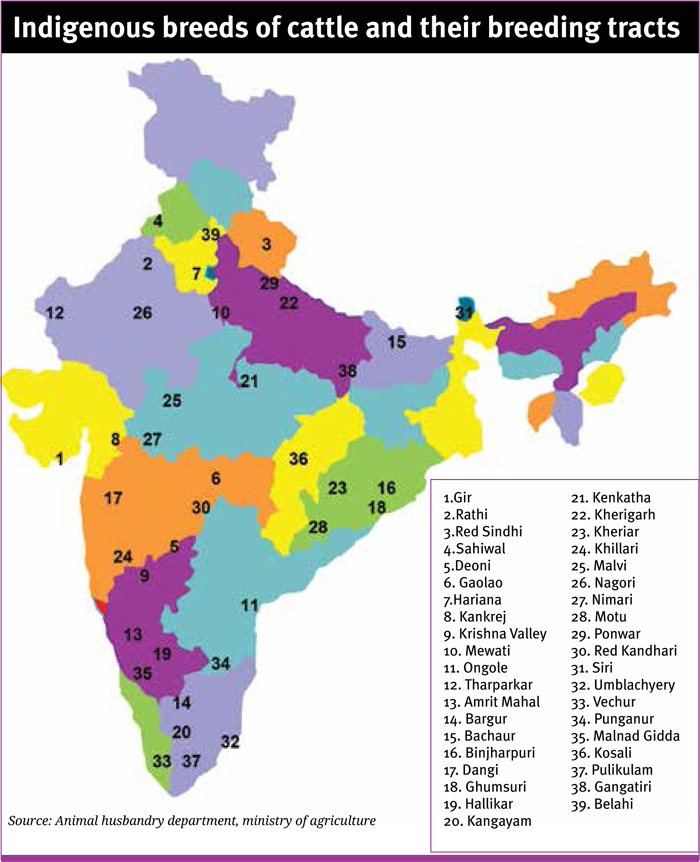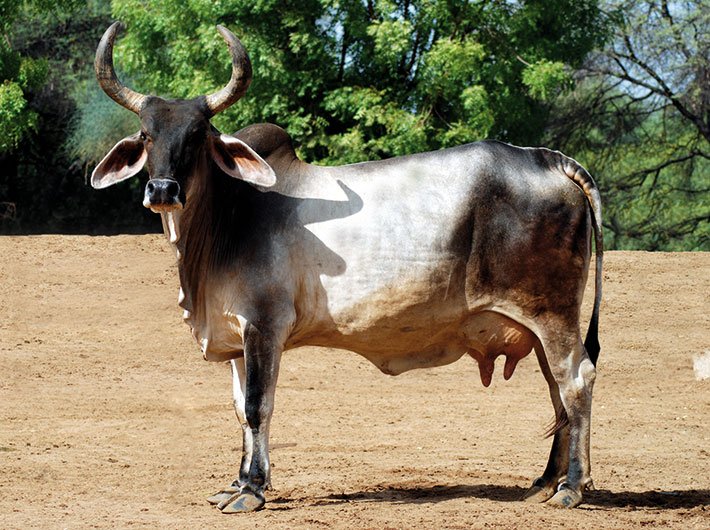Milk production will be affected by climate change but indigenous cow breeds can save the day. Farmers, however, see no benefit in their conservation. Now the government steps in
Cows sitting benignly in the middle of a busy road is such a common sight in India that one doesn’t even give much thought to it. But, now the central government is putting the spotlight on indigenous cows and is looking at making it an economically viable option to enhance milk productivity before global warming impacts overall production.
A study by the National Dairy Research Institute, Karnal, Haryana, a premier institute in dairy studies, has predicted a negative impact on milk production due to changing climatic conditions. The sector will have to bear a loss of 3.2 million metric tonnes of milk annually, costing more than Rs 5,000 crore.
These indigenous cow breeds can act as a silver bullet in tackling the impending crisis. The native breed is robust, resilient and is particularly suited to the climate and environment of their respective breeding tracts. The tract essentially means that a particular breed of cow is found in a particular region – like Gir (Gujarat), Sahiwal (Punjab), Red Sindhi (Haryana), Kankrej (Gujarat) and Rathi (Rajasthan).
The government is ready to shell out more than Rs 580 crore under Rashtriya Gokul Mission to conserve the indigenous breed which is facing the threat of disappearance due to competition from the exotic and crossbreeds.
Through Gokul Mission, started in 2014-15, the government has undertaken a breed improvement programme of the indigenous (desi) cattle, enhancement of milk production and productivity of native bovines, upgradation of nondescript (low productivity) breeds using elite indigenous breeds. Also distribution of disease-free high genetic merit bulls to farmers.
Policymakers believe that by the time the 12th five-year plan comes to an end in 2017, the domestic demand for milk would increase to 172 million metric tonnes. With current production at 147 million metric tonnes, the planning commission (now NITI Aayog) estimates show that the dairy industry has been growing by 4.8 percent annually.
The dairy sector, which has been witnessing a substantial growth since 1970 after Operation Flood, will be affected by the rising temperature, predict scientists.
According to officials, tapping the potential of the indigenous breed is the need of the hour. “In the absence of a specific programme on development and conservation of indigenous breeds, their (native breed) population has been declining and their performance is below the potential at present,” said OP Choudhary, joint secretary, department of animal husbandry, dairying and fisheries, ministry of agriculture and farmers welfare.
19th all India livestock census (in thousands)
Total exotic/ crossbreed
2007 – 33,060
2012 – 39,732
Percentage change – 20.18
Indigenous breed
2007 – 166,015
2012 – 151,172
Percentage change – (-8.94)
There are 39 native breeds, but not all of them are popular among farmers. There are only a handful of elite milch breeds – Sahiwal, Gir, Rathi, Tharparkar and Red Sindhi. Farmers are satisfied with them due to their economic viability.
But the problem is with the draft breeds/nondescript breeds which have low milk productivity – Amritmahal, Bachur, Bargur, Dangi, Hallikar, Kangayam, Kenkatha, Kherigarh, Khillari, Malvi, Nagori, Nimari, Ponwar, Umblachery, Red Khandari and Siri.
Unfortunately, out of 191 million cattle population in the country, 20-25 percent belong to recognised breeds while the rest are nondescript. The recognised breeds are those widely used by the farmers for their high productivity. They are referred to as elite milch breeds.
These draft breeds have poor genetic makeup. Generally, Indian breeds have an average milk yield of 1,500 litre/lactation (300 days) and when the bulls of these elite cows are used for breeding, the progeny carries 50 percent traits of each parent, with a chance of producing cows of 700-900 litre/lactation. The quality bulls of indigenous breeds are used for natural service as well as their semen is used for artificial insemination to produce good quality progeny. Such cows don’t attract farmers as they want to earn through milk production.
Therefore, they crossbreed those with exotic or foreign breeds. In India, Holstein-Friesian and Jersey are popular among farmers for crossbreeding due to their high productivity with 2,000-3,000 litre/lactation for 300 days.
Total exotic/crossbreed population increased by 20.18 percent in 2012 in comparison to 2007, according to the livestock census done in 2012 by department of animal husbandry.
On the other hand, the population of indigenous cattle decreased by 8.94 percent in 2012. In rural areas the population of the indigenous in-milch cattle, which are kept by farmers for milking, has decreased by 65 percent during 2007-12 as compared to 2003-07, whereas the population of exotic breeds increased by 23 percent.
The government has now taken a step that caters to all varieties of indigenous breed by establishing Gokul Gram, one of the major projects under Gokul Mission. It will primarily focus on managing urban cattle near metropolitan cities and the department has already spent Rs 200 crore for the ‘grams’.
It cannot be denied that in the past three decades, a substantial amount of work has been done in several states through gaushalas and cooperatives to conserve indigenous breeds.
Gokul grams
Land has been purchased in Maharashtra for three gokul grams – Pune, Amravati and Aarey Milk Colony in Mumbai. In Punjab, property for two grams has been purchased in Patiala. In Uttar Pradesh the investment has been in Mathura and Varanasi.
The plan rests upon genetic upgradation of the urban cattle, creating high genetic breeding stock and finally providing it to farmers. “It will take more than two years to develop infrastructure for these gokul grams,” said Choudhary.
Functioning on the public-private partnership model, each gram will have a capacity to shelter 1,000 indigenous cattle, comprising 60 percent milch and 40 percent unproductive cattle. Interestingly, maintenance of these nondescript breeds falls under the state government.
“It will be the duty of the state to bear the burden of unproductive herd of cows. They will have to develop a strategy in procuring these animals from farmers or farm owners,” said Choudhary.
The model, therefore, becomes interesting as the centre will bear the maintenance cost of productive cattle, while the state will be dealing with the remaining nondescript cows.
Perhaps this is one of the major loopholes of the scheme, diluting the accountability of the entire project.
Animal husbandry is a state matter and state governments spend a major proportion of their budget on disease control, treatment and artificial insemination (AI).
Merits of indigenous breeds
* Withstand harsh climatic conditions like drought
* Widely used for farming activities
* Disease resistant
* Produces milk of superior A2 quality. Breeds like Red Sindhi, Sahiwal, Tharparkar, Rathi, Gir have 100 percent A2 content, while other Indian breeds have 94 percent. On the other hand, exotic breed have only 60 percent A2 content
* Cow products are used for medicinal purpose
And their demerits
* Milk production is less in comparison to exotic or crossbreeds
* Desi cow calf starts producing milk after three years while exotic calf starts milking in two years
* A desi cow when sold in market costs '70,000 while an exotic or a crossbreed costs 'one lakh
“The resources allocated are not adequate to take care of all unwanted cows. Our policy should be to increase production without increasing the number of animals. The programme should have a clear economic analysis,” said Dr Narayan Hegde, principal advisor, BIAF (Bharatiya Agro Industries Foundation) Development Research Foundation, Pune. The organisation has been involved in inclusive development through dairy husbandry in the rural sector.
“Farmers are not interested in bearing the cost while the state governments have no requisite funds. The programme will be good for farmers as they can send their unwanted cows to reduce liability. However, making this programme viable with such low productive animals may be very difficult. It will require a long time investment to make the programme sustainable. Therefore, long term financial support is necessary,” he said.
Voicing apprehension about the scheme, Hegde said, “Sentiments and feelings should be secondary. There is no economic benefit data to convince farmers to take part in native breed conservation. With regard to crossbreeding, farmers are convinced of the benefits. If the programme is driven by funds from the donor, the enthusiasm will wither out once funding is discontinued. Thus, we should plan to develop programmes where farmers participate for generating supplementary income.”
Surya Kant Jalan of Surabhi Shodh Sansthan, Varanasi, too has questions about the effective implementation of the mission. Jalan has been working on the conservation of native breeds and in 2015, he highlighted the potential of Ganga Teri breed.
“In the absence of a clear policy, the outcome has been poor. Unless there is an economic benefit to the farmer, they will not adopt to the recommended policies,” said Jalan.
Genetic improvement
Another important aspect of the mission is the genetic upgradation of native breeds. In 2000, the BJP-led coalition government at the centre had taken an initiative to promote indigenous breed of cattle.
The National Project for Cattle and Buffalo Breeding (NPCBB) introduced superior bulls for breeding as well as quality control of semen banks. It turned out to be the most effective programme to increase the rate of artificial insemination and support semen station in improving the quality of semen. A semen station preserves the semen of good quality breed of bulls. If a bull is dead, its semen can be later used for artificial insemination. An improvement in the performance of the indigenous breed was needed.

The centre has launched National Programme for Bovine Breeding and Dairy Development at a cost of Rs 1,800 crore, where Rs 1,200 crore has been allocated for bovine breeding. Rashtriya Gokul Mission falls under this plan.
Over the years, the public machinery failed due to non-availability of superior quality breeding bulls, poor qualities of semen produced by many of the laboratories, inadequate skills of artificial insemination technicians, and poor technical assistance.
The genetic progress is stagnant as bulls of indigenous breeds in the semen station are not produced through organised breeding programmes like progeny testing and pedigree selection. They are selected merely on the basis of lactation yield and other information is not available. Therefore, their genetic potential is not known and is low.
There is hardly any record of maintenance. “It is not collected by animal husbandry statistics division of this department. However, looking at longevity of indigenous breeds and their low cost of maintenance, these animals may be sustainable to farmers in the long run,” said an animal husbandry official.
The Gokul Mission will restructure bull mother farms, which are centre- or state-run cattle breeding farms to produce highly exotic, crossbreeds or indigenous breed of bulls for semen production. These farms ensure that bulls and cattle are free from diseases. These farms will keep the record of elite bulls. These will be the places where bulls of high genetic value will be provided to farmers for natural service.
Currently, there are as many as 172 bull mother farms in the country run by the centre and state governments. These are currently in a dilapidated state. There is an absence of quality bulls and indigenous cow breed as well as lack of basic amenities like poor condition of shed and other equipments required for the maintenance of cattle and farms. So, the funds will be used to strengthen the existing infrastructure, and to purchase elite breeding stock.
Under the mission, 50 bull mother farms will be identified. The larger role, however, will be played by the National Kamdhenu Breeding Centre. It will function as a national repository of germplasm of all the native breed, make elite animals available for genetic upgradation programme in their respective breeding tracts and existing semen station and bull mother farms. Germplasm are cells which carry hereditary material. These are collected from animals, evaluated for quality and are frozen. The government is planning to establish two Kamdhenu centres – one in the north region and the other in the south.
Currently, most of the semen stations produce limited semen doses of only two to three indigenous breeds. Moreover, semen stations maintain only indigenous breeds which are in demand or are covered under the respective state breeding policies.
Out of 39 indigenous cattle breeds, semen of only nine breeds is currently available at the existing semen station.
Since quality semen for most of the indigenous breed is not available, farmers or breeders are dependent on bulls for natural service. Apparently, the genetic potential of these bulls is not known and they are obtained without proper testing for sexually transmitted disease.
The mission promises to give dividends to farmers but the major challenge is to change their attitude as they are not interested in conservation. They are interested in economic viability. The government needs to create awareness and provide quality desi breeds to farmers. Farmers and breeders have a clear idea of the cost and returns from dairy husbandry. Making the sector enterprising and in favour of native breed will be a herculean task.
Sustainability of the scheme is another big issue. Initially the centre will spend money to establish kamdhenu centres. Later the states will have to bear the maintenance cost. Thus, the success of the scheme will largely depend on them.
archana@governancenow.com
(The article appears in July 1-15, 2016 edition of Governance Now)

